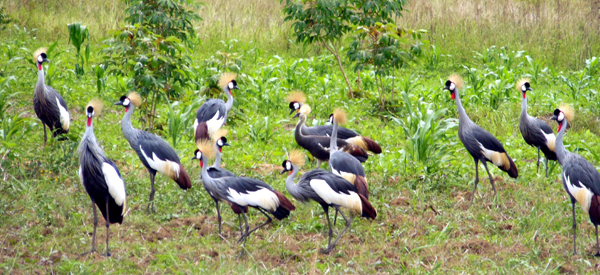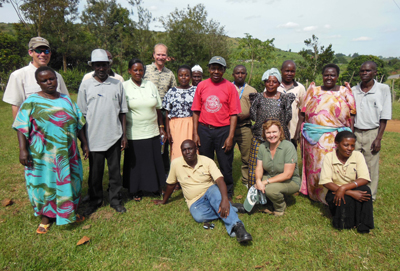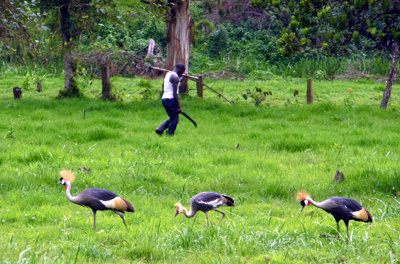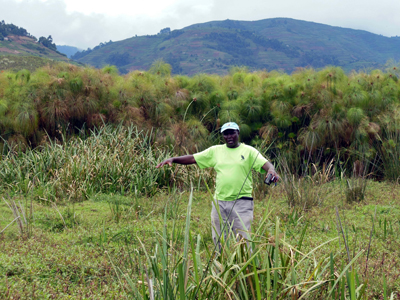
Grey Crowned Crane flock in Kaku Kiyanja, Uganda.
ICF President Dr. Rich Beilfuss recently returned from a three-week field visit to advance ICF’s Africa Program in three important “crane countries” — Uganda, Rwanda, and Zambia. Following are Rich’s field notes from Uganda, detailing the community-based efforts to protect the remaining Grey Crowned Cranes and their habitats in this rapidly changing country. Read Rich’s field notes from Rwanda and Zambia.
I first met Ugandan crane biologist and community leader Jimmy Muheebwa back in 2000. I am delighted to return to Uganda this year to see the fruits of our 12-year partnership with Jimmy and his colleagues at Nature Uganda. Our team includes Kerryn Morrison, who ably heads our ICF/Endangered Wildlife Trust partnership for Africa, and my old friend Maurice Wanjala, who has spearheaded efforts to save cranes and wetlands in northwest Kenya for more than 25 years. We are also joined by Rhett Turner and Greg Pope of Red Sky Productions, who are making a film about ICF and featuring the excellent community-based conservation work of Jimmy and Maurice here in East Africa.

Rich (center back) and Kerryn Morrison (center front), ICF’s African Crane Conservation
Program Manager, with the wetland conservation team in Uganda.
Of all the places in the world where cranes are cherished in local culture, Uganda is near the top of the list. The Grey Crowned Crane is the national bird of Uganda and is featured in the center of the national flag, on Uganda’s coat of arms, and on the 5 shilling coin. Uganda’s national bank is the “Crane Bank,” and there is a giant new crane statue in the capital city, Kampala. But for all its cultural prominence, the Grey Crowned Crane has hit very hard times in Uganda. Once considered the most secure of the African cranes, their population in Uganda has plummeted from perhaps 80,000 birds half a century ago to fewer than 10,000 today. This decline is mirrored in other countries throughout its range, and this June the Grey Crowned Crane will be formally designated as “Endangered”—an undesirable status shared only with the very rarest of cranes—Whooping, Siberian , and Red Crowned. The source of this decline is all too familiar—loss of wetland breeding grounds, and capture for illegal trade (learn more about ICF’s Africa Crane Trade Project).
Historically Grey Crowned Cranes bred on small wetlands scattered across the agricultural landscape, but today their breeding grounds are increasingly concentrated in Uganda’s few remaining large papyrus swamps. Kerryn and I discuss strategy for the region, and feel that our focus should now be on the 5-6 most important sites in East Africa that collectively sustain 10% or more of the population. Uganda has some of these critical wetlands, and the strongest wetland protection laws in Africa. Much of this protection was accomplished by Paul Mafabi, Commission of the Wetlands Program under the Minister of Environment. Paul visited ICF back in 1987, and did his Masters degree on Grey Crowned Cranes of eastern Uganda.
Widespread poverty in Uganda, coupled with a rapidly increasing human population, puts enormous pressure on these wetlands and most can no longer sustain breeding pairs. But this week we are visiting two important exceptions– Kaku Kiyanja and Nyamariru—where large numbers of breeding pairs still occur with occasional flocks of more than 300 birds. Kaku Kiyanja is a gorgeous reed marsh in the Ugandan hill country, draining to nearby Lake Victoria. Conservation efforts here are impressive—Jimmy has put together a wetland management team from among local community members, many of whom have committed to this effort for years. We observe many pairs of Grey Crowned Cranes scattered throughout the wetland, and half of them have nearly full-grown chicks. Kaku Kiyanja may be the most important breeding ground in the country, and a few surrounding wetlands show promise as well.

A Grey Crowned Crane pair and their chick (center) co-exist with local farmers in Kabale, Uganda.
Joseph of the wetland group hosts us for lunch, and we are given a tour of several demonstration projects the group is undertaking to improve human livelihoods around the wetland, including pig farming and bee-keeping hives made from wetland reeds.
Nymariru wetland is only a 100 miles or so to the southeast, but to reach there we cross into the Albertine Rift Valley–the most biologically-rich landscape of Africa and home to world’s remaining mountain gorillas, and also the most densely settled region in the world. Here, narrow bands of wetlands wind along the base of steep valleys. The surrounding landscape is a patchwork of small farm plots on incredibly steep slopes. The Albertine Rift has rich, fertile soils well-suited to intensive cropping, but erosion is rampant and soil fertility—and human livelihoods—are in decline.
We are encouraged to see many pairs of Grey Crowned Cranes in these papyrus wetlands, but none has a chick. In the uplands, a non-breeding flock of more than 80 cranes is gleaming seed and insects on farmlands—but all adults. Worrisome. But there is reason for hope. Jimmy has organized a community wetland management team here as well, and together they have restored a swath of papyrus six miles long by a hundred feet wide. With luck, this effort will provide enough cover for the cranes to successfully raise their chicks once again.

Jimmy leads a tour of the papyrus wetland restoration in the Albertine Rift Valley.
Illegal trade may pose a bigger problem. Crowned Cranes are a popular target for the global bird trade—some remain in the region as peacock-like pets, others are exported in large numbers for private collections and zoos around the world. Increasing human settlements around wetlands brings people closer and closer to crane breeding grounds, and the birds have nowhere to hide their nests and young chicks. Year after year, the chicks are taken from the nests. Some years ago, we did a study of the illegal trade of Black Crowned Cranes from the Inner Niger Delta in Mali – where, in a pattern that seems frighteningly similar to what we are now seeing in East Africa, the population crashed from tens of thousands in the 1970s to fewer than a hundred today. Birds were captured from nests and roosts in the delta, and carried in burlap sacks over long-distances in the hot Africa sun to cities where they were held for shipment. Losses were very high, perhaps as many as 8-9 birds dying for every individual that was successfully exported. Last year, we received word of a request from China for 500 wild-caught Grey Crowned Cranes. Filling such an order could decimate the remaining population.
We have much work to do to save these endangered cranes and their homes, and I am grateful for colleagues like Jimmy and Maurice who have dedicated their lives to this cause.
